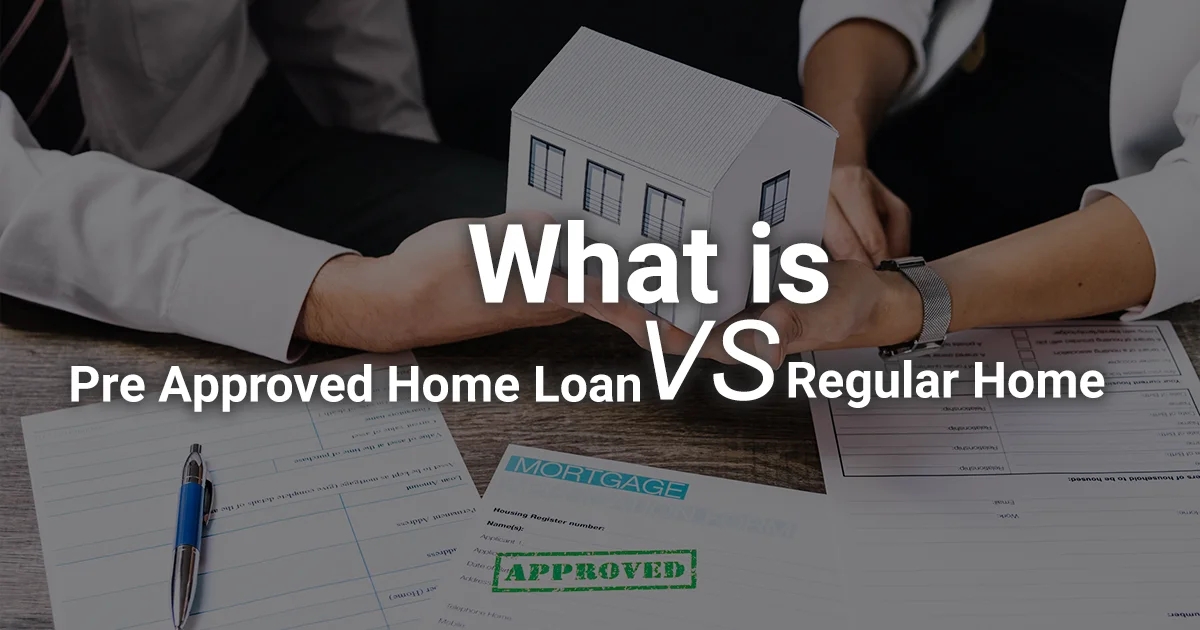A pre-approved house loan may be more advantageous than the conventional path in terms of time, clarity, and negotiating strength. Understanding the differences between pre-approved vs regular loans in terms of eligibility, cost, flexibility, and usefulness is essential before making a choice.
Pre-approvals provide benefits, such as quicker disbursements and better real estate bargains, but they can have drawbacks. However, standard house loans continue to be a dependable and popular choice for purchasers in all market sectors.
This blog provides a thorough rundown of both funding choices. We’ll explain what is pre approved home loan is, guide you through the application process, explain the associated costs, and assist in addressing a crucial query: Is a pre-approved home loan beneficial for your specific situation?
What is a Pre-Approved Home Loan and How Does It Work?
A home loan that has been approved by a bank or other financial organization prior to the borrower completing the purchase is known as a pre-approved home loan. The borrower’s income, creditworthiness, repayment history, and financial situation are the main factors that determine it. In essence, the bank assesses the application and verifies eligibility without requiring property specifics at this time.
Key Features:
- Approval is provided in principle.
- Valid typically for a limited duration (e.g., 3 to 6 months).
- Helps establish your budget before house hunting.
- Fast-tracks the final loan disbursal after property selection.
What is a Regular Home Loan?
Conversely, a regular home loan is a typical loan product that is applied for following the identification of a property. In this case, the bank assesses the property and the applicant before approving the loan. Only after the buyer completes the purchase does the procedure start.
Key Features:
- Requires complete property details.
- The sanction and disbursal process starts post-property selection.
- Typically, more time-consuming than pre-approvals.
- Standard for most first-time borrowers.
What is Pre-approved Home Loan Process
Subject to document verification, the pre-approved home loan procedure is rather simple and can frequently be finished in a few days. Here is a detailed explanation:
Submission of an Application
You formally apply to the lender, providing bank statements, identification, proof of address, and evidence of income.
Assessment of Creditworthiness
Your credit score, ability to repay, current debts, and steady income are all examined by the lender.
Evaluation of Loan Limits
The lender notifies you of the approved loan amount, which is the highest amount you are eligible to borrow, based on the evaluation.
Pre-Approval Letter Issuance
A letter outlining the qualifying loan amount, tentative interest rate, and validity period—typically three to six months—is sent to you if your application is accepted.
Finalization of the Property
Searching for a property within the authorized loan limit is what you do now. Only the due diligence pertaining to the property is completed after selection, and then the loan is disbursed.
Charges Associated With Pre-Approved Home Loans

It’s crucial to comprehend the potential pre-approved home loan fees, even when pre-approved loans could appear speedier and more convenient:
Processing Fee: An upfront cost to start the loan application procedure. If the loan is disbursed, some banks might return it.
Document charges: Document charges are costs associated with examining and validating documents that have been submitted.
Renewal Fees: Additional fees or a new application may be necessary for a renewal if the pre-approval validity expires.
Conversion Fee: Choosing the new interest rate could result in a fee if it changes between pre-approval and final disbursal.
It is generally a good idea to ask your lender about these fees in advance.
Pre-approved vs Regular Home Loans: A Comparative Analysis
| Parameter | Pre-approved Home Loan | Regular Home Loan |
| Loan Timing | Sanctioned before selecting a property | Sanctioned after the property is finalized |
| Focus of Evaluation | Applicant’s credit profile | Applicant’s profile and property documents |
| Processing Speed | Faster disbursal post-property finalization | Slower due to dual evaluations |
| Interest Rates | May offer slightly better rates due to the borrower’s profile-based approval | Standard interest rates apply |
| Validity | Valid for a limited period | No validity constraints |
| Negotiation Power | Enhances the buyer’s credibility and negotiation power | Limited bargaining advantage |
Is a Pre-approved Home Loan Good?
One common question prospective homebuyers ask is, “Is a pre-approved home loan good?” The answer depends on your buying intent and preparedness.
Advantages of Pre-approved Home Loans:
Faster Processing: Final loan disbursement occurs more quickly because financial eligibility has already been confirmed.
Budget Clarity: Buyers are able to shortlist properties within their budget because they are aware of their precise financing ability.
Better Negotiation Power: Buyers with available funds may be able to negotiate higher prices with sellers and developers.
Interest Rate Locks: During pre-approval, several lenders permit interest rate freezing.
Disadvantages to Consider:
Limited Validity: The procedure must be restarted if a property is not finalized within the allotted time.
Interest Rate Volatility: Unless locked, the promised interest rate may fluctuate by the time of disbursement.
Non-refundable Fees: Regardless of disbursement, certain banks may impose fees.
When Should You Choose a Pre-Approved Home Loan?
A pre-approved home loan is best suited for buyers who:
- Have not yet finalized a property, but want to plan.
- Want faster processing after property selection.
- Intend to negotiate better property deals using proof of funds.
- Want to explore multiple property options confidently.
Conversely, if you have already identified your property, a regular home loan is appropriate and will serve you just as well, provided you are not constrained by time.
Final Verdict: Which Home Loan is Best for You in 2025?
The decision between a pre-approved and a conventional house loan depends on your level of urgency and readiness.
A pre-approved house loan is quite beneficial if you are in the exploratory stage of the home-buying process and want to close quickly after the property is chosen.
A regular house loan is a tried-and-true option if you already have a property in mind and can afford the typical loan processing timescales.
Being financially prepared might make all the difference in today’s cutthroat real estate market. A pre-approved loan gives you a powerful negotiation position in addition to speeding up the purchasing process. It does, however, necessitate meticulous preparation, a steady revenue profile, and knowledge of related expenses.


